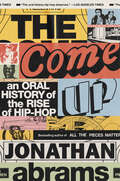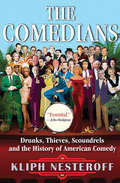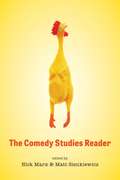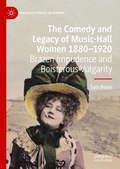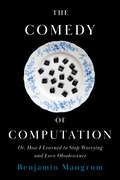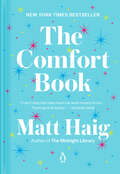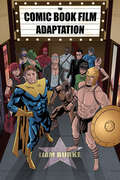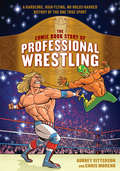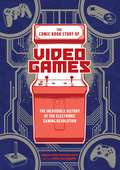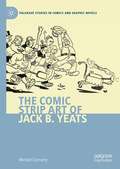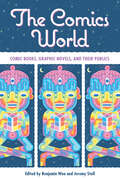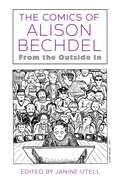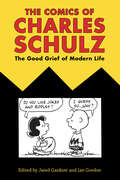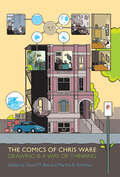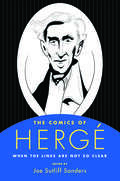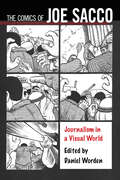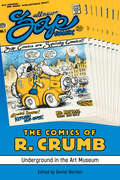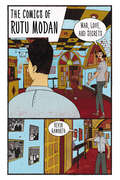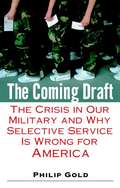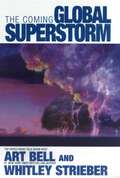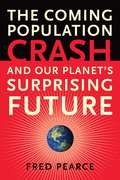- Table View
- List View
The Come Up: An Oral History of the Rise of Hip-Hop
by Jonathan AbramsThe essential oral history of hip-hop, from its origins on the playgrounds of the Bronx to its reign as the most powerful force in pop culture—from the award-winning journalist behind All the Pieces Matter, the New York Times bestselling oral history of The Wire &“The Come Up is Abrams at his sharpest, at his most observant, at his most insightful.&”—Shea Serrano, #1 New York Times bestselling author of Hip-Hop (And Other Things) The music that would come to be known as hip-hop was born at a party in the Bronx in the summer of 1973. Now, fifty years later, it&’s the most popular music genre in America. Just as jazz did in the first half of the twentieth century, hip-hop and its groundbreaking DJs and artists—nearly all of them people of color from some of America&’s most overlooked communities—pushed the boundaries of music to new frontiers, while transfixing the country&’s youth and reshaping fashion, art, and even language.And yet, the stories of many hip-hop pioneers and their individual contributions in the pre-Internet days of mixtapes and word of mouth are rarely heard—and some are at risk of being lost forever. Now, in The Come Up, the New York Times bestselling author Jonathan Abrams offers the most comprehensive account so far of hip-hop&’s rise, a multi-decade chronicle told in the voices of the people who made it happen. In more than three hundred interviews conducted over three years, Abrams has captured the stories of the DJs, executives, producers, and artists who both witnessed and themselves forged the history of hip-hop. Masterfully combining these voices into a seamless symphonic narrative, Abrams traces how the genre grew out of the resourcefulness of a neglected population in the South Bronx, and from there how it flowed into New York City&’s other boroughs, and beyond—from electrifying live gatherings, then on to radio and vinyl, below to the Mason-Dixon Line, west to Los Angeles through gangster rap and G-funk, and then across generations. Abrams has on record Grandmaster Caz detailing hip-hop&’s infancy, Edward &“Duke Bootee&” Fletcher describing the origins of &“The Message,&” DMC narrating his role in introducing hip-hop to the mainstream, Ice Cube recounting N.W.A&’s breakthrough and breakup, Kool Moe Dee recalling his Grammys boycott, and countless more key players. Throughout, Abrams conveys with singular vividness the drive, the stakes, and the relentless creativity that ignited one of the greatest revolutions in modern music. The Come Up is an exhilarating behind-the-scenes account of how hip-hop came to rule the world—and an essential contribution to music history.
The Comedians: Drunks, Thieves, Scoundrels, and the History of American Comedy
by Kliph NesteroffIn The Comedians, comedy historian Kliph Nesteroff brings to life a century of American comedy with real-life characters, forgotten stars, mainstream heroes and counterculture iconoclasts. Based on over two hundred original interviews and extensive archival research, Nesteroff’s groundbreaking work is a narrative exploration of the way comedians have reflected, shaped, and changed American culture over the past one hundred years.Starting with the vaudeville circuit at the turn of the last century, Nesteroff introduces the first stand-up comedian-an emcee who abandoned physical shtick for straight jokes. After the repeal of Prohibition, Mafia-run supper clubs replaced speakeasies, and mobsters replaced vaudeville impresarios as the comedian’s primary employer. In the 1950s, the late-night talk show brought stand-up to a wide public, while Lenny Bruce, Mort Sahl, and Jonathan Winters attacked conformity and staged a comedy rebellion in coffeehouses. From comedy’s part in the Civil Rights movement and the social upheaval of the late 1960s, to the first comedy clubs of the 1970s and the cocaine-fueled comedy boom of the 1980s, The Comedians culminates with a new era of media-driven celebrity in the twenty-first century.
The Comedy Studies Reader
by Nick Marx Matt SienkiewiczFrom classical Hollywood film comedies to sitcoms, recent political satire, and the developing world of online comedy culture, comedy has been a mainstay of the American media landscape for decades. Recognizing that scholars and students need an authoritative collection of comedy studies that gathers both foundational and cutting-edge work, Nick Marx and Matt Sienkiewicz have assembled The Comedy Studies Reader. This anthology brings together classic articles, more recent works, and original essays that consider a variety of themes and approaches for studying comedic media—the carnivalesque, comedy mechanics and absurdity, psychoanalysis, irony, genre, race and ethnicity, gender and sexuality, and nation and globalization. The authors range from iconic theorists, such as Mikhail Bakhtin, Sigmund Freud, and Linda Hutcheon, to the leading senior and emerging scholars of today. As a whole, the volume traces two parallel trends in the evolution of the field—first, comedy’s development into myriad subgenres, formats, and discourses, a tendency that has led many popular commentators to characterize the present as a “comedy zeitgeist”; and second, comedy studies’ new focus on the ways in which comedy increasingly circulates in “serious” discursive realms, including politics, economics, race, gender, and cultural power.
The Comedy and Legacy of Music-Hall Women 1880-1920: Brazen Impudence and Boisterous Vulgarity (Palgrave Studies in Comedy)
by Sam BealeThis book explores the comedy and legacy of women working as performers on the music-hall stage from 1880–1920, and examines the significance of their previously overlooked contributions to British comic traditions. Focusing on the under-researched female ‘serio-comic’, the study includes six micro-histories detailing the acts of Ada Lundberg, Bessie Bellwood, Maidie Scott, Vesta Victoria, Marie Lloyd and Nellie Wallace. Uniquely for women in the late-nineteenth and early-twentieth centuries, these pioneering performers had public voices. The extent to which their comedy challenged Victorian and Edwardian perceptions of women is revealed through explorations of how they connected with popular audiences while also avoiding censorship. Their use of techniques such as comic irony and stereotyping, self-deprecation, and comic innuendo are considered alongside the work of contemporary stand-up comedians and performance artists including Bridget Christie, Bryony Kimmings, Sara Pascoe, Shazia Mirza and Sarah Silverman.
The Comedy of Computation: Or, How I Learned to Stop Worrying and Love Obsolescence
by Benjamin MangrumIn this cultural history of the computer, Benjamin Mangrum shows that comedy has been central to how we've made sense of the technology's sweeping effects on public life and private experience. From the first Broadway play to include a computer in the 1950s to popular films like You've Got Mail and joke-telling digital assistants, Mangrum assembles an extensive archive of work by writers, filmmakers, programmers, engineers, and other technologists who have coupled comedy with computation. Many have used comedy to make the computer seem ordinary. Others have tried to stage the assimilation of computers within corporate life as a kind of comic drama. Mangrum describes these and many other ways in which comedy and computation have come together as a new genre of experience: the comedy of computation. The modern world exalts advances in technology, but we are constantly haunted by the specter of falling behind and becoming obsolete. Mangrum examines how comedy serves as a stage for working out these conflicted modes of experience in writing by Dave Eggers, Curtis Sittenfeld, Ishmael Reed, and Kurt Vonnegut Jr., among others, arguing that when we look at the comic forms that shape the cultures of computing, we come to better understand the tensions and contradictions internal to the social world we inhabit.
The Comfort Book
by Matt HaigThe new uplifting book from Matt Haig, the New York Times bestselling author of The Midnight Library, for anyone in search of hope, looking for a path to a more meaningful life, or in need of a little encouragement. <p><p> “It is a strange paradox, that many of the clearest, most comforting life lessons are learnt while we are at our lowest. But then we never think about food more than when we are hungry and we never think about life rafts more than when we are thrown overboard.” <p><p> THE COMFORT BOOK is Haig’s life raft: it’s a collection of notes, lists, and stories written over a span of several years that originally served as gentle reminders to Haig’s future self that things are not always as dark as they may seem. Incorporating a diverse array of sources from across the world, history, science, and his own experiences, Haig offers warmth and reassurance, reminding us to slow down and appreciate the beauty and unpredictability of existence.
The Comic Book Film Adaptation: Exploring Modern Hollywood's Leading Genre
by Liam BurkeIn the summer of 2000 X-Men surpassed all box office expectations and ushered in an era of unprecedented production of comic book film adaptations. This trend, now in its second decade, has blossomed into Hollywood's leading genre. From superheroes to Spartan warriors, The Comic Book Film Adaptation offers the first dedicated study to examine how comic books moved from the fringes of popular culture to the center of mainstream film production.Through in-depth analysis, industry interviews, and audience research, this book charts the cause-and-effect of this influential trend. It considers the cultural traumas, business demands, and digital possibilities that Hollywood faced at the dawn of the twenty-first century. The industry managed to meet these challenges by exploiting comics and their existing audiences. However, studios were caught off-guard when these comic book fans, empowered by digital media, began to influence the success of these adaptations. Nonetheless, filmmakers soon developed strategies to take advantage of this intense fanbase, while codifying the trend into a more lucrative genre, the comic book movie, which appealed to an even wider audience. Central to this vibrant trend is a comic aesthetic in which filmmakers utilize digital filmmaking technologies to engage with the language and conventions of comics like never before.The Comic Book Film Adaptation explores this unique moment in which cinema is stimulated, challenged, and enriched by the once-dismissed medium of comics.
The Comic Book Story of Professional Wrestling: A Hardcore, High-Flying, No-Holds-Barred History of the One True Sport (Comic Book Story of)
by Aubrey Sitterson Chris MorenoFrom the host of the critically acclaimed pro wrestling podcast Straight Shoot, this graphic novel history of wrestling features the key grapplers, matches, and promotions that shaped this beloved sport and form of entertainment.As a pop culture phenomenon, professional wrestling--with its heroic babyfaces and villainous heels performing suplexes and powerbombs in pursuit of championship gold--has conquered audiences in the United States and around the world. Now, writer/podcaster Aubrey Sitterson and illustrator Chris Moreno form a graphic novel tag team to present wrestling's complete illustrated history. Featuring legendary wrestlers like Bruno Sammartino, Hulk Hogan, and The Rock, and modern-day favorites like John Cena, Kenny Omega, and Sasha Banks, the book covers wrestling's progress from the carnival days of the Gold Dust Trio to the dominance of the WWF/WWE to today's diverse independent wrestling scene, and it spotlights wrestling's reach into Mexico/Puerto Rico (lucha libre), the U.K. (all-in), and Japan (puroresu).
The Comic Book Story of Video Games: The Incredible History of the Electronic Gaming Revolution (Comic Book Story of)
by Jonathan HennesseyA complete, illustrated history of video games--highlighting the machines, games, and people who have made gaming a worldwide, billion-dollar industry/artform--told in a graphic novel format. Author Jonathan Hennessey and illustrator Jack McGowan present the first full-color, chronological origin story for this hugely successful, omnipresent artform and business. Hennessey provides readers with everything they need to know about video games--from their early beginnings during World War II to the emergence of arcade games in the 1970s to the rise of Nintendo to today's app-based games like Angry Birds and Pokemon Go. Hennessey and McGowan also analyze the evolution of gaming as an artform and its impact on society. Each chapter features spotlights on major players in the development of games and gaming that contains everything that gamers and non-gamers alike need to understand and appreciate this incredible phenomenon.
The Comic Everywoman in Irish Popular Theatre: Political Melodrama, 1890-1925 (Palgrave Studies in Comedy)
by Susanne CollearyThis book is a comprehensive study of comic women in performance as Irish Political Melodrama from 1890 to 1925. It maps out the performance contexts of the period, such as Irish “poor” theatre both reflecting and complicating narratives of Irish Identity under British Rule. The study investigates the melodramatic aesthetic within these contexts and goes on to analyse a selection of the melodramas by the playwrights J.W. Whitbread and P.J. Bourke. In doing so, the analyses makes plain the comic structures and intent that work across both character and action, foregrounding comic women at the centre of the discussion. Finally, the book applies a “practice as research” dimension to the study. Working through a series of workshops, rehearsals and a final performance, Colleary investigates comic identity and female performance through a feminist revisionist lens. She ultimately argues that the formulation of the Comic Everywoman as staged “Comic” identity can connect beyond the theatre to her “Everyday” self. This book is intended for those interested in theatre histories, comic women and in popular performance.
The Comic Self: Toward Dispossession (Thinking Theory)
by Grant Farred Timothy C. CampbellA provocative and unconventional call to dispossess the self of itself Challenging the contemporary notion of &“self-care&” and the Western mania for &“self-possession,&” The Comic Self deploys philosophical discourse and literary expression to propose an alternate and less toxic model for human aspiration: a comic self. Timothy Campbell and Grant Farred argue that the problem with the &“care of the self,&” from Foucault onward, is that it reinforces identity, strengthening the relation between I and mine. This assertion of self-possession raises a question vital for understanding how we are to live with each other and ourselves: How can you care for something that is truly not yours?The answer lies in the unrepresentable comic self. Campbell and Farred range across philosophy, literature, and contemporary comedy—engaging with Socrates, Burke, Hume, Hegel, Marx, Nietzsche, Heidegger, Derrida, Deleuze, and Levinas; Shakespeare, Cervantes, Woolf, Kafka, and Pasolini; and Stephen Colbert, David Chappelle, and the cast of Saturday Night Live. They uncover spaces where the dispossession of self and, with it, the dismantling of the regime of self-care are possible. Arguing that the comic self always keeps a precarious closeness to the tragic self, while opposing the machinations of capital endemic to the logic of self-possession, they provide a powerful and provocative antidote to the tragic self that so dominates the tenor of our times.
The Comic Strip Art of Jack B. Yeats (Palgrave Studies in Comics and Graphic Novels)
by Michael ConnertyThis monograph seeks to recover and assess the critically neglected comic strip work produced by the Irish painter Jack B. Yeats for various British publications, including Comic Cuts, The Funny Wonder, and Puck, between 1893 and 1917. It situates the work in relation to late-Victorian and Edwardian media, entertainment and popular culture, as well as to the evolution of the British comic during this crucial period in its development. Yeats’ recurring characters, including circus horse Signor McCoy, detective pastiche Chubblock Homes, and proto-superhero Dicky the Birdman, were once very well-known, part of a boom in cheap and widely distributed comics that Alfred Harmsworth and others published in London from 1890 onwards. The repositioning of Yeats in the context of the comics, and the acknowledgement of the very substantial corpus of graphic humour that he produced, has profound implications for our understanding of his artistic career and of his significant contribution to UK comics history. This book, which also contains many examples of the work, should therefore be of value to those interested in Comics Studies, Irish Studies, and Art History.
The Comics World: Comic Books, Graphic Novels, and Their Publics
by Benjamin Woo and Jeremy StollContributions by Bart Beaty, T. Keith Edmunds, Eike Exner, Christopher J. Galdieri, Ivan Lima Gomes, Charles Hatfield, Franny Howes, John A. Lent, Amy Louise Maynard, Shari Sabeti, Rob Salkowitz, Kalervo A. Sinervo, Jeremy Stoll, Valerie Wieskamp, Adriana Estrada Wilson, and Benjamin Woo The Comics World: Comic Books, Graphic Novels, and Their Publics is the first collection to explicitly examine the production, circulation, and reception of comics from a social-scientific point of view. Designed to promote interdisciplinary dialogue about theory and methods in comics studies, this volume draws on approaches from fields as diverse as sociology, political science, history, folklore, communication studies, and business, among others, to study the social life of comics and graphic novels. Taking the concept of a “comics world”—that is, the collection of people, roles, and institutions that “produce” comics as they are—as its organizing principle, the book asks readers to attend to the contexts that shape how comics move through societies and cultures. Each chapter explores a specific comics world or particular site where comics meet one of their publics, such as artists and creators; adaptors; critics and journalists; convention-goers; scanners; fans; and comics scholars themselves. Through their research, contributors demonstrate some of the ways that people participate in comics worlds and how the relationships created in these spaces can provide different perspectives on comics and comics studies. Moving beyond the page, The Comics World explores the complexity of the lived reality of the comics world: how comics and graphic novels matter to different people at different times, within a social space shared with others.
The Comics of Alison Bechdel: From the Outside In (Critical Approaches to Comics Artists Series)
by Janine UtellContributions by Michelle Ann Abate, Leah Anderst, Alissa S. Bourbonnais, Tyler Bradway, Natalja Chestopalova, Margaret Galvan, Judith Kegan Gardiner, Katie Hogan, Jonathan M. Hollister, Yetta Howard, Katherine Kelp-Stebbins, Don L. Latham, Vanessa Lauber, Katherine Parker-Hay, Anne N. Thalheimer, Janine Utell, and Susan R. Van Dyne Alison Bechdel is both a driver and beneficiary of the welcoming of comics into the mainstream. Indeed, the seemingly simple binary of outside/inside seems perpetually troubled throughout the career of this important comics artist, known for Fun Home, Are You My Mother?, and Dykes to Watch Out For. This volume extends the body of scholarship on her work from a range of interdisciplinary perspectives. In a definitive collection of original essays, scholars cover the span of Bechdel’s career, placing her groundbreaking early work within the context of her more well-known recent projects. The contributors provide new insights on major themes in Bechdel’s work, such as gender performativity, masculinity, lesbian politics and representation, trauma, life writing, and queer theory. Situating Bechdel among other comics artists, this book charts possible influences on her work, probes the experimental traits of her comics in their representations of kinship and trauma, combs archival materials to gain insight into Bechdel’s creative process, and analyzes her work in community building and space making through the comics form. Ultimately, the volume shows that Bechdel’s work consists of performing a series of selves—serializing the self, as it were—each constructed and refracted across and within her chosen artistic modes and genres.
The Comics of Charles Schulz: The Good Grief of Modern Life (Critical Approaches to Comics Artists Series)
by Jared Gardner and Ian GordonWith contributions by Leonie Brialey, MJ Clarke, Roy T. Cook, Joseph J. Darowski, Ian Gordon, Gene Kannenberg Jr., Christopher P. Lehman, Anne C. McCarthy, Ben Owen, Lara Saguisag, Ben Saunders, Jeffrey O. Segrave, and Michael TisserandThe Comics of Charles Schulz collects new essays on the work of the creator of the immensely popular Peanuts comic strip. Despite Schulz's celebrity, few scholarly books on his work and career have been published. This collection serves as a foundation for future study not only of Charles Schulz (1922-2000) but, more broadly, of the understudied medium of newspaper comics.Schulz's Peanuts ran for a half century, during which time he drew the strip and its characters to express keen observations on postwar American life and culture. As Peanuts' popularity grew, Schulz had opportunities to shape the iconography, style, and philosophy of modern life in ways he never could have imagined when he began the strip in 1950. Edited by leading scholars Jared Gardner and Ian Gordon, this volume ranges over a spectrum of Schulz's accomplishments and influence, touching on everything from cartoon aesthetics to the marketing of global fast food. Philosophy, ethics, and cultural history all come into play. Indeed, the book even highlights Snoopy's global reach as American soft power.As the broad interdisciplinary range of this volume makes clear, Peanuts offers countless possibilities for study and analysis. From many perspectives--including childhood studies, ethnic studies, health and exercise studies, as well as sociology--The Comics of Charles Schulz offers the most comprehensive and diverse study of the most influential cartoonist during the second half of the twentieth century.
The Comics of Chris Ware: Drawing Is a Way of Thinking
by David M. Ball Martha B. KuhlmanWith contributions by David M. Ball, Georgiana Banita, Margaret Fink Berman, Jacob Brogan, Isaac Cates, Joanna Davis-McElligatt, Shawn Gilmore, Matt Godbey, Jeet Heer, Martha B. Kuhlman, Katherine Roeder, Peter R. Sattler, Marc Singer, Benjamin Widiss, and Daniel WordenThe Comics of Chris Ware: Drawing Is a Way of Thinking brings together contributions from established and emerging scholars about the comics of Chicago-based cartoonist Chris Ware (b. 1967). Both inside and outside academic circles, Ware's work is rapidly being distinguished as essential to the developing canon of the graphic novel. Winner of the 2001 Guardian First Book Prize for the genre-defining Jimmy Corrigan: The Smartest Kid on Earth, Ware has received numerous accolades from both the literary and comics establishment. This collection addresses the range of Ware's work from his earliest drawings in the 1990s in The ACME Novelty Library and his acclaimed Jimmy Corrigan, to his most recent works-in-progress, “Building Stories” and “Rusty Brown.”
The Comics of Hergé: When the Lines Are Not So Clear (Critical Approaches to Comics Artists Series)
by Joe Sutliff SandersContributions by Jônathas Miranda de Araújo, Guillaume de Syon, Hugo Frey, Kenan Koçak, Andrei Molotiu, Annick Pellegrin, Benjamin Picado, Vanessa Meikle Schulman, Matthew Screech, and Gwen Athene Tarbox As the creator of Tintin, Hergé (1907–1983) remains one of the most important and influential figures in the history of comics. When Hergé, born Georges Prosper Remi in Belgium, emerged from the controversy surrounding his actions after World War II, his most famous work leapt to international fame and set the standard for European comics. While his style popularized what became known as the “clear line” in cartooning, this edited volume shows how his life and art turned out much more complicated than his method. The book opens with Hergé’s aesthetic techniques, including analyses of his efforts to comprehend and represent absence and the rhythm of mundaneness between panels of action. Broad views of his career describe how Hergé navigated changing ideas of air travel, while precise accounts of his life during Nazi occupation explain how the demands of the occupied press transformed his understanding of what a comics page could do. The next section considers a subject with which Hergé was himself consumed: the fraught lines between high and low art. By reading the late masterpieces of the Tintin series, these chapters situate his artistic legacy. A final section considers how the clear line style has been reinterpreted around the world, from contemporary Francophone writers to a Chinese American cartoonist and on to Turkey, where Tintin has been reinvented into something meaningful to an audience Hergé probably never anticipated. Despite the attention already devoted to Hergé, no multi-author critical treatment of his work exists in English, the majority of the scholarship being in French. With contributors from five continents drawing on a variety of critical methods, this volume’s range will shape the study of Hergé for many years to come.
The Comics of Joe Sacco: Journalism in a Visual World (Critical Approaches to Comics Artists Series)
by Daniel WordenNamed a Notable Scholarly Publication of 2015 by the Comics Studies SocietyContributions by Georgiana Banita, Lan Dong, Ann D'Orazio, Kevin C. Dunn, Alexander Dunst, Jared Gardner, Edward C. Holland, Isabel Macdonald, Brigid Maher, Ben Owen, Rebecca Scherr, Maureen Shay, Marc Singer, Richard Todd Stafford, and Øyvind VågnesThe Comics of Joe Sacco addresses the range of his award-winning work, from his early comics stories as well as his groundbreaking journalism Palestine (1993) and Safe Area to Goražde (2000), to Footnotes in Gaza (2009) and his most recent book The Great War (2013), a graphic history of World War I.First in the series, Critical Approaches to Comics Artists, this edited volume explores Sacco's comics journalism and features established and emerging scholars from comics studies, cultural studies, geography, literary studies, political science, and communication studies. Sacco's work has already found a place in some of the foundational scholarship in comics studies, and this book solidifies his role as one of the most important comics artists today.Sections focus on how Sacco's comics journalism critiques and employs the standard of objectivity in mainstream reporting, what aesthetic principles and approaches to lived experience can be found in his comics, how Sacco employs the space of the comics page to map history and war, and the ways that his comics function in the classroom and as human rights activism. The Comics of Joe Sacco offers definitive, exciting approaches to some of the most important--and necessary--comics today, by one of the most acclaimed journalist-artists of our time.
The Comics of Julie Doucet and Gabrielle Bell: A Place inside Yourself (Critical Approaches to Comics Artists Series)
by Tahneer Oksman and Seamus O’MalleyWinner of the 2020 Comics Studies Society Edited Book PrizeContributions by Kylie Cardell, Aaron Cometbus, Margaret Galvan, Sarah Hildebrand, Frederik Byrn Køhlert, Tahneer Oksman, Seamus O’Malley, Annie Mok, Dan Nadel, Natalie Pendergast, Sarah Richardson, Jessica Stark, and James Yeh In a self-reflexive way, Julie Doucet’s and Gabrielle Bell’s comics, though often autobiographical, defy easy categorization. In this volume, editors Tahneer Oksman and Seamus O’Malley regard Doucet’s and Bell’s art as actively feminist, not only because they offer women’s perspectives, but because they do so by provocatively bringing up the complicated, multivalent frameworks of such engagements. While each artist has a unique perspective, style, and worldview, the essays in this book investigate their shared investments in formal innovation and experimentation, and in playing with questions of the autobiographical, the fantastic, and the spaces in between. Doucet is a Canadian underground cartoonist, known for her autobiographical works such as Dirty Plotte and My New York Diary. Meanwhile, Bell is a British American cartoonist best known for her intensely introspective semiautobiographical comics and graphic memoirs, such as the Lucky series and Cecil and Jordan in New York. By pairing Doucet alongside Bell, the book recognizes the significance of female networks, and the social and cultural connections, associations, and conditions that shape every work of art. In addition to original essays, this volume republishes interviews with the artists. By reading Doucet’s and Bell’s comics together in this volume housed in a series devoted to single-creator studies, the book shows how, despite the importance of finding “a place inside yourself” to create, this space seems always for better or worse a shared space culled from and subject to surrounding lives, experiences, and subjectivities.
The Comics of R. Crumb: Underground in the Art Museum (Critical Approaches to Comics Artists Series)
by Daniel WordenContributions by José Alaniz, Ian Blechschmidt, Paul Fisher Davies, Zanne Domoney-Lyttle, David Huxley, Lynn Marie Kutch, Julian Lawrence, Liliana Milkova, Stiliana Milkova, Kim A. Munson, Jason S. Polley, Paul Sheehan, Clarence Burton Sheffield Jr., and Daniel Worden From his work on underground comix like Zap and Weirdo, to his cultural prominence, R. Crumb is one of the most renowned comics artists in the medium’s history. His work, beginning in the 1960s, ranges provocatively and controversially over major moments, tensions, and ideas in the late twentieth and early twenty-first centuries, from the counterculture and the emergence of the modern environmentalist movement, to racial politics and sexual liberation. While Crumb’s early work refined the parodic, over-the-top, and sexually explicit styles we associate with underground comix, he also pioneered the comics memoir, through his own autobiographical and confessional comics, as well as in his collaborations. More recently, Crumb has turned to long-form, book-length works, such as his acclaimed Book of Genesis and Kafka. Over the long arc of his career, Crumb has shaped the conventions of underground and alternative comics, autobiographical comics, and the “graphic novel.” And, through his involvement in music, animation, and documentary film projects, Crumb is a widely recognized persona, an artist who has defined the vocation of the cartoonist in a widely influential way. The Comics of R. Crumb: Underground in the Art Museum is a groundbreaking collection on the work of a pioneer of underground comix and a fixture of comics culture. Ranging from art history and literary studies, to environmental studies and religious history, the essays included in this volume cast Crumb's work as formally sophisticated and complex in its representations of gender, sexuality, race, politics, and history, while also charting Crumb’s role in underground comix and the ways in which his work has circulated in the art museum.
The Comics of Rutu Modan: War, Love, and Secrets (Great Comics Artists Series)
by Kevin HaworthBest known for her Eisner Award–winning graphic novels, Exit Wounds and The Property, Rutu Modan’s richly colored compositions invite readers into complex Israeli society, opening up a world too often defined only by news headlines. Her strong female protagonists stick out in a comics scene still too dominated by men, as she combines a mystery novelist’s plotting with a memoirist’s insights into psychology and trauma. The Comics of Rutu Modan: War, Love, and Secrets conducts a close reading of her work and examines her role in creating a comics arts scene in Israel. Drawing upon archival research, Kevin Haworth traces the history of Israeli comics from its beginning as 1930s cheap children’s stories, through the counterculture movement of the 1970s, to the burst of creativity that began in the 1990s and continues full force today. Based on new interviews with Modan (b. 1966) and other comics artists, Haworth indicates the key role of Actus Tragicus, the collective that changed Israeli comics forever and launched her career. Haworth shows how Modan’s work grew from experimental minicomics to critically acclaimed graphic novels, delving into the creative process behind Exit Wounds and The Property. He analyzes how the recurring themes of family secrets and absence weave through her stories and how she adapts the famous clear line illustration style to her morally complex tales. Though still relatively young, Modan has produced a remarkably varied oeuvre. Identifying influences from the United States and Europe, Haworth illustrates how Modan’s work is global in its appeal, even as it forms a core of the thriving Israeli cultural scene.
The Coming Draft: The Crisis in Our Military and Why Selective Service Is Wrong for America
by Philip GoldA frustrating war and an endless occupation. The very real prospect of more conflict overseas. A military stretched beyond its breaking point. The stage is set for the resumption of the draft. Now, in an explosive and provocative book, Philip Gold, a former Marine and a disaffected conservative, reveals why selective service should never come to pass but might.
The Coming Global Superstorm
by Art Bell Whitley StrieberKiller tornadoes. Violent tropical storms. Devastating temperatures. Are these just the prelude to an unprecedented environmental disaster in our near future? Two of America's leading investigators of unexplained phenomena -- Art Bell, the top-rated late-night radio talk-show host, and Whitley Strieber, No. 1 New York Times bestselling author of Communion and the legendary Nature's End -- have made a shocking discovery based on years of research with top scientists and archaeologists from around the world. Now, they reveal what powerful interests are trying to keep hidden: rapid changes in the atmosphere caused by greenhouse gases have set humanity on an incredibly dangerous course toward a catastrophic change in climate in the immediate future. It will begin with a massive, unprecedented storm that will devastate the Northern Hemisphere. This will be followed by floods unlike anything ever seen before -- or perhaps a new Ice Age. They also unearth evidence that this has happened in the past -- in fact, that it has occurred regularly throughout geologic history, but so infrequently that our only record of the last such storm is contained in ancient myths and flood legends. From El Niño to the African droughts, to the shrinking of the polar ice caps, Bell and Strieber identify the warning signs to those willing to see. They point out that the Earth's regulatory system is like a rubber band: you can stretch it just so far before it snaps back -- with a vengeance. Since 1995, each successive year has set new records for violent weather. In 1999 a major climatological study predicted that the Earth will soon be warmer than it has been in millions of years. Bell and Strieber tell us why they believe a rebound is imminent -- a rapid and violent cooling that will cover the Northern Hemisphere in a sheath of choking ice and snow. But it's not too late to reverse our destiny. No mere harbinger of an inevitable doomsday, The Coming Global Superstorm is instead a spirited call to action that offers a wealth of viable solutions to this mammoth challenge to humankind. Through a careful and impressively researched dissection of the myths and legends of ancient cultures and an insightful examination of the best of modern environmental science, Bell and Strieber guide us on an intellectual journey as dark as the murky origins of man and as bright as the promise of an interstellar future.
The Coming Man from Canton: Chinese Experience in Montana, 1862–1943 (Historical Archaeology of the American West)
by Christopher W. MerrittIn The Coming Man from Canton Christopher W. Merritt mines the historical and archaeological record of the Chinese immigrant experience in Montana to explore new questions and perspectives. During the 1860s Chinese immigrants arrived by the thousands, moving into the Rocky Mountain West and tenaciously searching for prosperity in the face of resistance, restriction, racism, and armed hostility from virtually every ethnic group in American society. As second-class citizens, Chinese immigrants remained largely insular and formed their own internal governments as well as labor and trade networks, typically establishing communities apart from the main towns. Chinese miners, launderers, restaurant keepers, gardeners, railroad laborers, and other workers became a separate but integral part of the American experience in the Intermountain West. Although Chinese immigrants constituted more than 10 percent of the Montana Territory’s total population by 1870, the historical records provide a biased and narrow perspective, as they were generally written by European American community members. Merritt uses the statewide Montana context to show the diversity of Chinese settlements that has often been neglected by archival studies. His research highlights how the legacy of the Chinese in Montana is, or is not, reflected in modern Montana identity and how scholars, educators, professionals, and the public can alter the existing perception of this population as the “other” and perceive it instead an integral part of Montana’s past.
The Coming Population Crash and Our Planet's Surprising Future
by Fred PearceA leading environmental writer looks at the unexpected effects—and possible benefits—of a shrinking, graying population. Over the last century, the world’s population quadrupled and fears of overpopulation flared, with baby booms blamed for genocide and terrorism, and overpopulation singled out as the primary factor driving global warming. Yet, surprisingly, it appears that the population explosion is past its peak—by mid-century, the world’s population will be declining for the first time in over seven hundred years. In The Coming Population Crash, veteran environmental writer Fred Pearce reveals the dynamics behind this dramatic shift and describes the environmental, social, and economic effects of our surprising demographic future.
